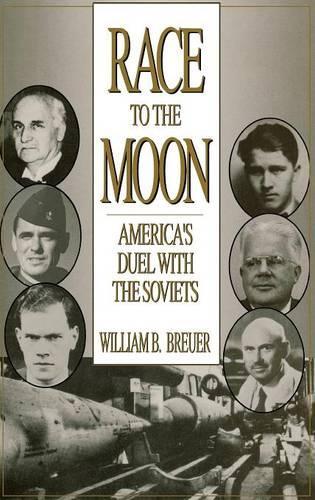
Race to the Moon: America's Duel with the Soviets
(Hardback)
Publishing Details
Race to the Moon: America's Duel with the Soviets
By (Author) William B. Breuer
Bloomsbury Publishing PLC
Praeger Publishers Inc
27th July 1993
United States
Classifications
Professional and Scholarly
Non Fiction
Astronautics
History of the Americas
International relations
629.4709
Physical Properties
Hardback
232
Width 156mm, Height 235mm
624g
Description
"Race to the Moon" traces the story of how America got to the moon before Communist Russia. The book opens with an appeal by President John F. Kennedy for winning the space race, then flashes back to World War II and traces the history of rocket development by the Germans, who were 25 years ahead of all other nations in rocket R&D. The book tells of feuds among Nazi leaders about who should control the rocket programme, the struggles of German space scientists to persuade Nazi leadership to invest in rocket research, and, finally, the hundreds of individual espionage efforts that went into smuggling information about this new technology out of the Reich and into the hands of British Intelligence. Breuer tells of how young US army officers discovered an underground cache of long-range rockets toward the end of the war and managed to "sneak" them to America. These same young Americans (and others) mounted a Germany-wide search for rocket scientists, and managed to locate 200 of them, offer them contracts, and bring them and their families to the United States under top-secret security. These German scientists, headed by 31-year-old Wernher von Braun, led America's rocket research and development during the Cold War and finally took NASA to a triumphant moon landing.
Reviews
Another smasher by Breuer, who specializes in thrilling reports of WW II spycraft and warfare. . . . Crackerjack war adventures--and, in this case, the moon's the limit.-Kirkus Reviews
Highly recommended. General community college; undergraduate; pre-professional.-Choice
His military perspective serves him well in the chapters tracing the V-2's development history, the Allies' undercover espionage and overt military efforts to neutralize the weapon, and the fateful decision by von Braun's team to seek out and surrender to the Allies to avoid capture by the Soviets in the waning days of the war.-Library Journal
The latest of Breuer's well-written books is more like his espionage histories-Hoodwinking Hitler, for instance-than like his more numerous battle and campaign narratives. Using abundant primary and secondary sources, many recently declassified, Breuer unfolds and engrossing narrative that will make space advocates weep with frustration when they see how much faster and farther we could have gone in laying the foundations of a permanent American space effort.-Booklist
"Another smasher by Breuer, who specializes in thrilling reports of WW II spycraft and warfare. . . . Crackerjack war adventures--and, in this case, the moon's the limit."-Kirkus Reviews
"Highly recommended. General community college; undergraduate; pre-professional."-Choice
"His military perspective serves him well in the chapters tracing the V-2's development history, the Allies' undercover espionage and overt military efforts to neutralize the weapon, and the fateful decision by von Braun's team to seek out and surrender to the Allies to avoid capture by the Soviets in the waning days of the war."-Library Journal
"The latest of Breuer's well-written books is more like his espionage histories-Hoodwinking Hitler, for instance-than like his more numerous battle and campaign narratives. Using abundant primary and secondary sources, many recently declassified, Breuer unfolds and engrossing narrative that will make space advocates weep with frustration when they see how much faster and farther we could have gone in laying the foundations of a permanent American space effort."-Booklist
Author Bio
WILLIAM B. BREUER landed with the first assault waves in Normandy on D-Day, then fought across Europe. Later, he founded a daily newspaper in Rolla, Missouri, and after that, a highly successful public relations firm in St. Louis. He has been writing books full time since 1982, twelve of which are now in paperback, and eight of which have become main selections of the Military Book Club.
